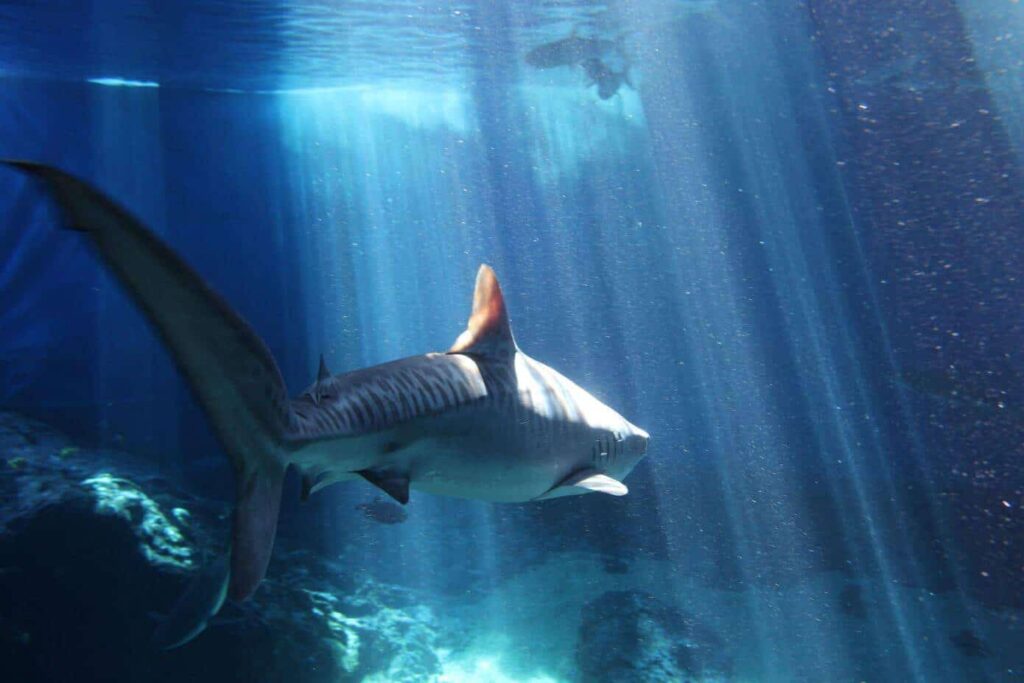The Open Ocean Exhibit is home to a stunning variety of sharks and rays found in Hawaiian waters. Inside the exhibit, you’ll find over 50 different species of fish, totaling several hundred individuals. The population is ever-changing as our curatorial team brings in new animals and releases others so visitors can always expect something new during each visit.
The exhibit also features a walkthrough underwater tunnel that allows visitors to feel as though they are surrounded by the ocean. The tunnel offers a 360-degree view, giving you the opportunity to observe marine life from all angles and get an up-close look at the incredible biodiversity of the open ocean.
One notable creature in the exhibit is the Hawaiian broad stingray, also known as “lupe” in Hawaiian. These stingrays have a unique body shape and are bottom dwellers. They use their fins to glide across the sand and their mouths underneath to sift through sediment for food. Their eyes on top help them stay alert for predators.
Stingrays have an intriguing respiratory system that sets them apart from other marine animals. They breathe through spiracles, located on the top of their bodies, which pump oxygenated water over their gills. A fascinating feature of stingrays is their barb, filled with a toxin that serves as their primary defense mechanism. While often misunderstood, it’s important to note that stingrays are generally docile creatures that prefer to avoid confrontation.

Within the Open Ocean exhibit, a diverse array of sharks can be found, each with its unique markings and characteristics. From the sandbar shark (Manō) with its prominent dorsal fins to the gray reef shark with its charcoal gray margin on the caudal fin, and the blacktip reef shark (Manō Pā‘ele) with its distinct black-tipped fins, visitors can marvel at the remarkable diversity of these apex predators. The exhibit also occasionally showcases other species such as tiger sharks (Manō) and hammerheads (Manō Kihikihi), adding an element of excitement to each visit.
Sharks play a crucial role in maintaining the balance of ocean ecosystems. As apex predators and scavengers, they regulate fish populations and keep the environment clean by targeting weak or dying animals. However, sharks have long suffered from negative media representation, leading to fear and misconceptions. This, in turn, has resulted in retaliatory actions and the unnecessary loss of countless shark lives. Educating the public about the importance of sharks is crucial to their conservation, and aquariums like the Maui Ocean Center are at the forefront of these efforts.
By visiting the Open Ocean exhibit and learning about sharks and rays, visitors become part of the movement to dispel irrational fears and help protect these magnificent creatures. Through education and awareness, we can reshape public perceptions and work towards a future where sharks are revered as vital guardians of our oceans. Aquariums and education centers worldwide are dedicated to this mission, and by supporting their initiatives, we contribute to the preservation of marine life and the health of our oceans.
Kaho’olawe: A STORY OF HISTORY AND HEALING Kaho‘olawe has long been a sacred and storied place for Native Hawaiians. Steeped...
hawaiians and the sea At Maui Ocean Center we take pride in our commitment to immersing ourselves in the culturally...
maui Sea Turtles Lagoon exhibit THE GREEN SEA TURTLE IS The Largest Sea Turtle in the World Get acquainted with...
HUMPBACK Whales OF HAWAIʻI EXHIBIT & SPHERE Discover the largest 3d Sphere in the world! WHEN WAS THE LAST TIME...
living reef exhibit at maui ocean center Home to one of the world’s largest displays of live Pacific corals, Maui...
Immerse Yourself in our SEA-News featuring Hawaiʻi’s marine life, inspirational conservation, and glimpses behind-the-scenes.